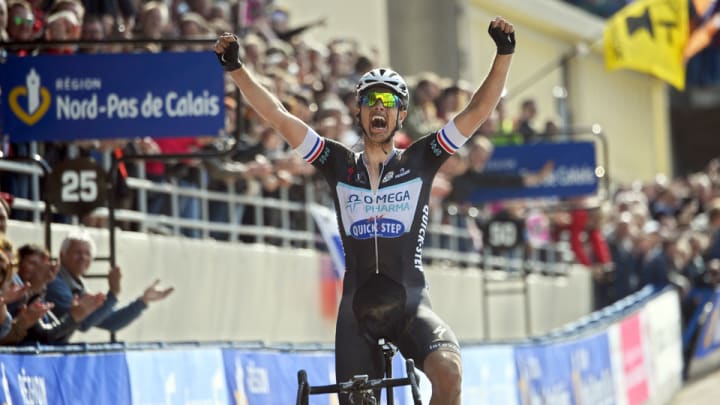It was a Hell of a Race: Surviving the Paris-Roubaix Cycle Classic

Taylor Phinney wasn’t going to win Paris-Roubaix, the one-day classic contested yesterday over 257 rugged kilometers from France and into Belgium. But from where the BMC rider sat, jackhammering over cobblestones 15 kilometers from the finish of the race known as l’Enfer du Nord—the Hell of the North—a top-10 finish, maybe even a podium spot, seemed possible. Phinney was mixing it up with favorites Tom Boonen and Fabian (Spartacus) Cancellara, legendary hard men who’d won seven of the nine previous editions of this ordeal—which, in a rank upset, was snatched from them on Sunday by Boonen’s opportunistic teammate, the Dutchman Niki Terpstra.
Yes, Phinney was “running out of steam,” in that moment, he later allowed. But strange, unpredictable things happen on this dastardly course, fifty clicks of which are raced over crash-sowing, chaos-inducing sections of cobbled pave. So the 23-year-old dug deeper, until one of those things happened to him: an irregular cobble in a notoriously uneven section called the Carrefour de l’arbre caused a pinch flat in his rear tire. In that moment, Phinney’s top-10 hopes evanesced like the dust clouds churned up by the peloton.
In that moment, he loathed the race that he loves more than any other. Phinney has now done Paris-Roubaix three times as a pro. “That’s the first time I’ve ever made it to that section and been able to look up and see the front of the race,” he reported over the phone a few hours later, “even though I didn’t have the energy to look up and see the front of the race.”
There are five one-day “classics” on the European calendar, races so difficult and tradition-drenched they’re called “Monuments.” Paris-Roubaix is by far the most famous and beloved of those five, the so-called “Queen of the Classics.”
PHOTO GALLERY: Hell of the North: The Paris-Roubaix
(Photo: AFP/Getty Images)

If Paris-Roubaix were really a queen, she’d be into leather and bondage. This course is capricious, cruel, difficult beyond reason. Five-time Tour de France winner Bernard Hinault despised this race, famously calling it calling it "connerie"—stupidity—despite winning in 1981 in what The Guardian described as “a wet, miserable cows---bath of a race suffering multiple punctures and crashes and winning by sheer force of will and bloody mindedness.”
“It’s a bollocks, this race,” fulminated Theo de Rooij in 1985. “You’re working like an animal, you don’t have time to [pee], you wet your pants. You’re riding in mud, you’re slipping—it’s a pile of s---.”
Would he take the start in Paris-Roubaix again?
“Sure! It’s the most beautiful race in the world!”
On Sunday, there was undeniable beauty in the sight of John Murphy, a 29-year-old from Horse Shoe, N.C., sneaking into a breakaway group that led the race for four hours. A flat tire 67km from the finish put an end to his time at the front. But what a time it was for Murphy, a lead-out specialist and journeyman for United Healthcare, who put in the ride of his life.
There was beauty in the sight of 2012 Tour de France winner Bradley Wiggins suffering, faltering, then gutting out a ninth-place finish. Having made his bones as a great stage racer, he didn’t need to shell himself for six hours on Sunday. But he wanted to. He’d fallen in love with Paris-Roubaix as a boy, Wiggins explained earlier this week, riding up and down a cobbled mews in London “pretending I was Johan Meseeuw,” a three-time Hell of the North winner.
"For me it is the biggest cycle race in the world. Bigger than the Tour de France …. When I retire from cycling it will be the only race I tune into every year.”
There was reckless, heedless beauty in Boonen’s repeated attacks, none of which stuck—he could be seen haranguing riders around him for not working with him, or for going too slow when they did—but which animated the race and ratcheted up the suffering of his rivals.
More From Austin Murphy:
Touching BASE With the Freedom Tower Jumpers
Big Wheels: Drake High's Mountain Biking Dynasty
The Ax-Man Cometh: Arden Cogar Jr. Rules Timbersports
Likewise, Terpstra’s perfectly timed strike just under six kilometers from the finish combined a cobra’s quickness and the wiles of a seasoned card sharp. It was evident almost immediately that no one in the chase group of 10 riders, not even Spartacus, had the legs or the will to bring him back.
Not beautiful, by any stretch: the trophy presented to the winner, an actual mounted cobblestone that the rider is then required to hold indefinitely, prolonging his physical suffering.
There is something rough-hewn and authentic about that talisman, though. It’s just the right the touch, in truth, for this old-school celebration of pain. “This is cycling at its core,” says Phinney. “Not to say that the other races aren’t difficult, because for sure we suffer a lot. But there’s something about the dirt and the mud and the cobbles—about being able to transport yourself back in time. When you cross the line, no matter what place you’re in, you’re pretty proud of the fact that you were able to finish the race. Because it is that brutal.
“I love it.”
What’s not to love about the most beautiful race in the world?
